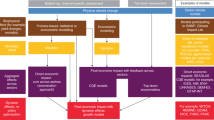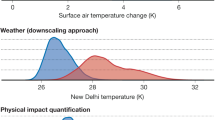Abstract
Climate change impact assessments often apply models of individual sectors such as agriculture, forestry and water use without considering interactions between these sectors. This is likely to lead to misrepresentation of impacts, and consequently to poor decisions about climate adaptation. However, no published research assesses the differences between impacts simulated by single-sector and integrated models. Here we compare 14 indicators derived from a set of impact models run within single-sector and integrated frameworks across a range of climate and socio-economic scenarios in Europe. We show that single-sector studies misrepresent the spatial pattern, direction and magnitude of most impacts because they omit the complex interdependencies within human and environmental systems. The discrepancies are particularly pronounced for indicators such as food production and water exploitation, which are highly influenced by other sectors through changes in demand, land suitability and resource competition. Furthermore, the discrepancies are greater under different socio-economic scenarios than different climate scenarios, and at the sub-regional rather than Europe-wide scale.
This is a preview of subscription content, access via your institution
Access options
Subscribe to this journal
Receive 12 print issues and online access
$209.00 per year
only $17.42 per issue
Buy this article
- Purchase on Springer Link
- Instant access to full article PDF
Prices may be subject to local taxes which are calculated during checkout





Similar content being viewed by others
References
Kovats, S. et al. in Climate Change 2014: Mitigation of Climate Change (eds Bogataj, L. K., Corobov, R. & Vallejo, R.) Ch. 23 (IPCC, Cambridge Univ. Press, 2014).
Audsley, E., Trnka, M., Sabaté, S. & Sanchez, A. Interactive modelling of land profitability to estimate European agricultural and forest land use under future scenarios of climate, socio-economics and adaptation. Climatic Change 128, 215–227 (2015).
Audsley, E., Pearn, K. R., Harrison, P. A. & Berry, P. M. The impact of future socio-economic and climate changes on agricultural land use and the wider environment in East Anglia and North West England using a meta-model system. Climatic Change 90, 57–88 (2008).
Holman, I. P., Harrison, P. A. & Metzger, M. Cross-sectoral impacts of climate and socio-economic change in Scotland—implications for adaptation policy. Reg. Environ. Change 16, 97–109 (2016).
Holman, I. P. et al. A regional, multi-sectoral and integrated assessment of the impacts of climate and socio-economic change in the UK: II Results. Climatic Change 80, 43–73 (2005).
Wimmer, F. et al. Modelling the effects of cross-sectoral water allocation schemes in Europe. Climatic Change 128, 229–244 (2015).
Rosenzweig, C. et al. The agricultural model intercomparison and improvement project (AgMIP): protocols and pilot studies. Agric. For. Meteorol. 170, 166–182 (2013).
IPCC Climate Change 2014: Impacts, Adaptation, and Vulnerability (eds Field, C. B. et al.) 1–1132 (Cambridge Univ. Press, 2014).
IPCC Climate Change 2014: Impacts, Adaptation, and Vulnerability (eds Barros, V. R. et al.) 1133–1820 (Cambridge Univ. Press, 2014).
Huber, V. et al. Climate impact research: beyond patchwork. Earth Syst. Dynam. 5, 399–408 (2014).
Warren, R. The role of interactions in a world implementing adaptation and mitigation solutions to climate change. Phil. Trans. R. Soc. A 369, 217–241 (2011).
Harrison, P. A., Holman, I. P. & Berry, P. M. Assessing cross-sectoral climate change impacts, vulnerability and adaptation: an introduction to the CLIMSAVE project. Climatic Change 128, 153–167 (2015).
Harrison, P. A. et al. Combining qualitative and quantitative understanding for exploring cross-sectoral climate change impacts, adaptation and vulnerability in Europe. Reg. Environ. Change 13, 761–780 (2013).
Harrison, P. A. et al. Cross-sectoral impacts of climate change and socio-economic change for multiple European land- and water-based sectors. Climatic Change 128, 279–292 (2015).
Mokrech, M., Kebede, A. S., Nicholls, R. J., Wimmer, F. & Feyen, L. An integrated approach for assessing flood impacts due to future climate and socio-economic conditions and the scope of adaptation in Europe. Climatic Change 128, 245–260 (2015).
Dunford, R., Smith, A., Harrison, P. A. & Hangau, D. Ecosystem service provision in a changing Europe: adapting to the impacts of combined climate and socio-economic change. Landscape Ecol. 30, 443–461 (2015).
Dunford, R., Harrison, P. A., Jäger, J., Rounsevell, M. D. A. & Tinch, R. Exploring climate change vulnerability across sectors and scenarios using indicators of impacts and coping capacity. Climatic Change 128, 339–354 (2015).
Jäger, J. et al. Assessing policy robustness of climate change adaptation measures across sectors and scenarios. Climatic Change 128, 395–407 (2015).
Kebede, A. S. et al. The sensitivity of cross-sectoral impacts to climate and socio-economic drivers for key European sectors. Climatic Change 128, 261–277 (2015).
Dunford, R., Harrison, P. A. & Rounsevell, M. D. A. Exploring scenario and model uncertainty in cross-sectoral integrated assessment approaches to climate change impacts. Climatic Change 132, 417–432 (2014).
Brown, C. et al. Analysing uncertainties in climate change impact assessment across sectors and scenarios. Climatic Change 128, 293–306 (2015).
Nakićenović, N. et al. Special Report on Emissions Scenarios (Cambridge Univ. Press, 2000).
Dubrovsky, M., Trnka, M., Holman, I. P., Svobodova, E. & Harrison, P. A. Developing a reduced-form ensemble of climate change scenarios for Europe and its application to selected impact indicators. Climatic Change 128, 169–186 (2015).
Busch, G. Future European agricultural landscapes—what can we learn from existing quantitative land use scenario studies? Agric. Ecosyst. Environ. 114, 121–140 (2006).
Arnell, N. W. et al. A global assessment of the effects of climate policy on the impacts of climate change. Nature Clim. Change 3, 512–519 (2013).
Holman, I. & Cojocaru, G. Report Describing the Integrated Assessment Platform (IAP) Specification, Meta-model Specifications and the Multi-scale Approach. (CLIMSAVE Project, 2011); http://www.climsave.eu/climsave/doc/Report_on_the_specification_of_the_IAP.pdf
Rounsevell, M. D. A. et al. A coherent set of future land use change scenarios for Europe. Agric. Ecosyst. Environ. 114, 57–68 (2006).
Abildtrup, J. et al. Socio-economic scenario development for the assessment of climate change impacts on agricultural land use: a pairwise comparison approach. Environ. Sci. Policy 9, 101–115 (2006).
Lin, L. I. K. A concordance correlation coefficient to evaluate reproducibility. Biometrics 45, 255–268 (1989).
Acknowledgements
The research leading to these results has received funding from the European Commission Seventh Framework Programme under Grant Agreement no. 244031 (The CLIMSAVE Project; www.climsave.eu) and no. 603416 (The IMPRESSIONS project; Impacts and risks from higher-end scenarios: strategies for innovative solutions). The authors wish to thank all the modellers that contributed towards the development of the IAP in these projects.
Author information
Authors and Affiliations
Contributions
P.A.H. conceived the idea for the study; all authors designed the study; R.W.D. undertook the model runs and data analysis; all authors contributed towards the writing of the paper.
Corresponding author
Ethics declarations
Competing interests
The authors declare no competing financial interests.
Supplementary information
Supplementary Information
Supplementary Information (PDF 1059 kb)
Rights and permissions
About this article
Cite this article
Harrison, P., Dunford, R., Holman, I. et al. Climate change impact modelling needs to include cross-sectoral interactions. Nature Clim Change 6, 885–890 (2016). https://doi.org/10.1038/nclimate3039
Received:
Accepted:
Published:
Issue Date:
DOI: https://doi.org/10.1038/nclimate3039
This article is cited by
-
Towards scenario representation of adaptive capacity for global climate change assessments
Nature Climate Change (2023)
-
The politics of climate risk assessment
npj Climate Action (2023)
-
Climate change–driven agricultural frontiers and their ecosystem trade-offs in the hills of Nepal
Regional Environmental Change (2023)
-
A bibliometric review of climate change cascading effects: past focus and future prospects
Environment, Development and Sustainability (2023)
-
Machine learning–based observation-constrained projections reveal elevated global socioeconomic risks from wildfire
Nature Communications (2022)



